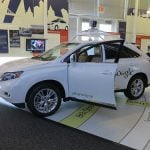Shared autonomous vehicles may cut parking needs by 90% – study
Ridesharing in self-driving cars may reduce the demand for parking in urban areas by up to 90 percent, according to a recent study led by Wenwen Zhang, “Exploring the Impact of Shared Autonomous Vehicles on Urban Parking Demand: An Agent-based Simulation Approach,” which investigates the potential impact of shared autonomous vehicles, or SAVs, on urban parking. Urban parking may also be distributed in a new way, once SAVs are widely adopted. As the researchers explain, “These driverless vehicles are expected to introduce more fundamental changes to human travel behavior, which may lead to different social structures and urban forms.”

Another study on parking impacts of SAVs, another prediction of massive land use changes. Image from Dean Hochman.
Self-driving cars will not only fill in the gaps as well as expand upon the ride- and car-sharing programs we now use, but more reliably and with greater accessibility, and likely as an on-demand taxi service. Passengers who don’t know each other will share rides “with minimal increases in travel time and cost, write the researchers, and the cars will most likely “operate with a higher passenger load and automatically navigate to locations from where trips will originate, thereby reducing parking demand.”
For this particular study, researchers estimated parking levels under differently sized fleets of SAVs, as well as under different passenger wait times. The fleet size ranges from 500 to 800 vehicles, “with various levels of willingness for ride-sharing,” and with varied empty vehicle cruising strategies. The results from the simulation show how many parking spaces are saved when using SAVs, and also show where the most reductions in parking can be expected in the study’s particular city.
Building on previous studies which have also studied the impact of SAVs, the researchers developed a model with three significant improvements over previous studies’ models: “first, it operationalized a dynamic ride-sharing system with two agents who are served by one SAV based on each agent’s preferences for sharing. Second, it tested different vehicle assignment methods based on clients’ preferences for both out-of-pocket and time costs to explore system performance.Third, it examined empty vehicle cruising strategies to determine their impact on parking demand and the spatial distribution.
In the no-ridesharing model, parking demand was shown to be “sensitive” to the number of SAVs in the system. So, SAVs can be reduced in order to reduce parking, but only to a point — if the total number of vehicles is too small, the quality of the system will decrease. In this study, 700 vehicles were necessary in order to keep customers’ waiting times down to about two minutes.In the ridesharing model, parking demand was sometimes sensitive to the willingness of customers to share rides, and in the vehicle empty cruising model, parking demand was found to be able to be reduced further by “sacrificing” vehicle miles traveled, or VMT.
The takeaway from each of these three models? Up to 90 percent of household parking demand can be reduced with the use of 700 SAVs. Reduced parking space has a number of pluses, point out the researchers. “Once those urban parking spaces are no longer in need, more sustainable designs, such as more green, open, and human oriented space can be introduced,” the write. “Planners and local decision makers may seize this opportunity to guide the city in a more sustainable way.”
Related Posts
Category: Parking Tech

















